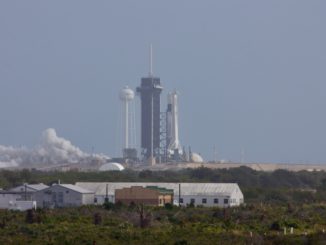Science
SpaceX Achieves Key Milestone with Super Heavy-Starship Test Flight

A SpaceX Super Heavy-Starship rocket successfully launched on August 26, 2025, marking a significant milestone for the company after a series of earlier failures. The test flight, which took off from SpaceX’s Starbase in Texas, demonstrated improved performance and control, culminating in a planned splashdown in the Indian Ocean.
Delayed by two days due to technical issues and adverse weather, the launch showcased the rocket’s capabilities. With a powerful thrust of approximately 16 million pounds, the Super Heavy, equipped with 33 methane-fueled Raptor engines, lifted off at 7:30 p.m. ET. It successfully propelled the Starship upper stage out of the lower atmosphere before performing a controlled descent.
During the flight, one of the Raptor engines was intentionally shut down to simulate a failure. Despite this, the booster compensated effectively, executing a tail-first descent into the Gulf of Mexico as planned. SpaceX employees celebrated this achievement, particularly after experiencing three consecutive test flight failures earlier in the year.
The mission’s success is crucial for SpaceX, especially as the company aims to refine the Super Heavy-Starship for operational missions, including launching satellites and eventually ferrying settlers to Mars. This test flight also plays a vital role in NASA’s future plans, as the agency relies on a modified version of the Starship for lunar missions, with a potential crewed landing targeted for 2027.
The Starship upper stage successfully completed a sub-orbital flight and deployed eight Starlink satellite simulators during the mission. This deployment tested the rocket’s mechanisms and verified the ability to reignite its engines in space. However, upon re-entry, the vehicle faced intense heat, which damaged some protective components, including a skirt surrounding the engine bay and a control flap. Despite these issues, the Starship maintained its stability and control throughout the descent.
SpaceX’s ability to address the technical challenges of re-entering Earth’s atmosphere remains critical as it prepares for future missions. The company aims to establish a reliable launch cadence, a requirement for the ambitious plans to support NASA’s Artemis program and potential lunar exploration.
While the recent flight showcased significant advancements, concerns linger regarding the timeline for the lunar variant of the Starship. Observers are questioning whether SpaceX can achieve the necessary milestones in time to compete with other nations, including China, which has plans for its lunar missions by the end of the decade.
Experts from NASA and the aerospace community have expressed skepticism about the feasibility of a crewed moon landing in 2027 with the current Human Landing System architecture. A senior engineer involved in the Artemis program stated, “We are not going to go ahead and get a crewed Starship to the moon by 2030, under any circumstances.”
As SpaceX continues to innovate and address the technical challenges of space travel, the outcome of this test flight serves as both a victory and a reminder of the hurdles that lie ahead. The company remains committed to refining its technology with the goal of expanding human presence beyond Earth.
-

 Technology4 months ago
Technology4 months agoDiscover the Top 10 Calorie Counting Apps of 2025
-

 Health2 months ago
Health2 months agoBella Hadid Shares Health Update After Treatment for Lyme Disease
-

 Health3 months ago
Health3 months agoErin Bates Shares Recovery Update Following Sepsis Complications
-

 Technology3 weeks ago
Technology3 weeks agoDiscover 2025’s Top GPUs for Exceptional 4K Gaming Performance
-

 Technology2 months ago
Technology2 months agoElectric Moto Influencer Surronster Arrested in Tijuana
-

 Technology4 months ago
Technology4 months agoDiscover How to Reverse Image Search Using ChatGPT Effortlessly
-

 Technology4 months ago
Technology4 months agoMeta Initiates $60B AI Data Center Expansion, Starting in Ohio
-

 Technology4 months ago
Technology4 months agoRecovering a Suspended TikTok Account: A Step-by-Step Guide
-

 Health4 months ago
Health4 months agoTested: Rab Firewall Mountain Jacket Survives Harsh Conditions
-

 Lifestyle4 months ago
Lifestyle4 months agoBelton Family Reunites After Daughter Survives Hill Country Floods
-

 Technology3 months ago
Technology3 months agoUncovering the Top Five Most Challenging Motorcycles to Ride
-

 Technology4 weeks ago
Technology4 weeks agoDiscover the Best Wireless Earbuds for Every Lifestyle




















